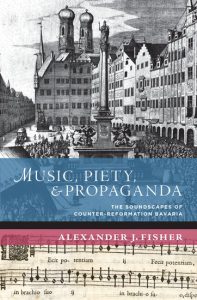Adina par excellence: Eugenia Tadolini and the Performing Tradition of Donizetti’s L’elisir d’amore in Vienna
Author: Vellutini, Claudio Publication details: Nineteenth-Century Music 38, no. 1 (2014): 3-29 Weblink: http://ncm.ucpress.edu Abstract: Gaetano Donizetti’s L’elisir d’amore was subjected to a series of substantial modifications after its premiere in 1832. In this article I focus on the performing tradition of the opera in Vienna. The history of these performances and their reception allow us to examine […]
Music, Piety, and Propaganda: The Soundscapes of Counter-Reformation Bavaria
Author: Fisher, Alexander Publication details: The New Cultural History of Music. New York: Oxford University Press, 2014. Weblink: https://global.oup.com Abstract: Music, Piety, and Propaganda: The Soundscapes of Counter-Reformation Bavaria explores the nature of sound as a powerful yet ambivalent force in the religious struggles that permeated Germany during the Counter-Reformation. Author Alexander J. Fisher goes beyond a […]
Beopgo Changshin: New Music for Samul nori
Author: Hesselink, Nathan Publication details: Musicology in Korea, ed. Kim Sejung, 495-507. Seoul: Minsogwŏn, 2014
A Geometry of Music: Harmony and Counterpoint in the Extended Common Practice
Author: Roeder, John Publication details: Journal of Music Theory 57, no. 1 (2013): 159–191 Weblink: https://dukeupress.edu
Can musicians track two different beats simultaneously?
Author: Poudrier, Ève, Repp, B.H. Publication details: Music Perception: An Interdisciplinary Journal 30, no. 4 (2013): 369-90. Weblink: http://cogsys.ubc.ca Abstract: The simultaneous presence of different meters is not uncommon in Western art music and the music of various non-Western cultures. However, it is unclear how listeners and performers deal with this situation, and whether it is […]
Radiohead’s ‘Pyramid Song’: Ambiguity, Rhythm, and Participation
Author: Hesselink, Nathan Publication details: Music Theory Online 19, no. 1 (March 2013). Weblink: http://mtosmt.org Abstract: This article demonstrates how the confluence of ambiguity and rhythm in a pop/rock song creates a powerful force for audience participation. Focusing on Radiohead’s “Pyramid Song” (2001) as a case study, I document in detail the myriad ways listening audiences have made sense […]
Verdi beyond Verdi
Author: Vellutini, Claudio Publication details: Cambridge Opera Journal 25, no. 3 (2013): 319-28 Weblink: http://academia.edu
Potentiel polymétrique et réalisation dans l’œuvre d’Elliott Carter: Ébauche d’une approche analytique multivalente
Author: Poudrier, Ève Publication details: Hommage à Elliott Carter, edited by Max Noubel, 147-174. France: Editions Delatour, 2013.
Detecting perturbations in polyrhythms: Effects of complexity and attentional strategies
Author: Fidali, B. C., Poudrier, Ève, Repp, B. H. Publication details: Psychological Research 77, no. 2 (2011): 183-95. Weblink: http://cogsys.sites.olt.ubc.ca Abstract: Jones et al. in Journal of Experimental Psychology Human Perception and Performance 21:293–307, 1995, showed that a temporal perturbation is easier to detect in a 3:2 polyrhythm than in a single-stream isochronous baseline condition if the two isochronous […]
Multiple temporalities: Speeds, beat cues, and beat tracking in Carter’s instrumental music
Author: Poudrier, Ève Presentation details: Joint Conference of the American Musicological Society (AMS), Society for Music Theory (SMT), and Society for Ethnomusicology (SEM), New Orleans (LA), 3 November 2012 Weblink: http://indiana.edu Abstract: In the music of Elliott Carter, multiple temporalities usually involve the simultaneous presence of contrasting speeds and beat structures made tangible through the use of different […]
